Assessment of 13 Gridded Precipitation Datasets for Hydrological Modeling in a Mountainous Basin
Abstract
:1. Introduction
2. Materials and Methods
2.1. Study Area
2.2. Hydro-Meteorological Data
2.3. Methodology
3. Result and Discussion
3.1. Spatial and Temporal Evaluation of Daily Precipitation
3.2. Consistency of GPDs over Time and Space
3.3. GPD Precipitation Intensity Comparison
3.4. Evaluation of GPD Detectability
3.5. Hydrologic Evaluation of GPDs
4. Conclusions
- CPCv1 gathers information from ground station networks and displays a high performance for the rainfall distribution over time and space. This dataset also presents better detectability in terms of precipitation intensity and demonstrates valuable results when used in streamflow simulations.
- Among multi-source merging datasets, MSWEPv2.8 shows close performance to CPCv1 followed by CHIRPSv2.0 and CHIRPv2.0 for direct gauge comparison. CHIRPSv2.0 and CHIRPv2.0 outperform MSWEPv2.8 in accurately simulating streamflow especially in Scheme-1, but not in Scheme-2. GPDs which only use gauge and satellite data such as IMERGHHFv06, TMPA-3B42v7, and PERSIANN-CDR perform poorly in capturing precipitation intensities and show low reproducibility for streamflow generation in Scheme-1.
- Within satellite-based GPDs, IMERGHHEv06 and IMERGHHLv06 are able to perform better compared to other satellite-based products. While TMPA-3B42RTv7 and PERSIANN-CCS show low performance at all stages, PERSIANN generally underestimates precipitation. ERA5 shows slightly good performance both in spatial and temporal validation when compared to satellite-based GPDs and displays similar results for streamflow prediction in Scheme-2.
- Some satellite-based GPDs are becoming available with high spatial resolution and short time lag (latency) which is very important for real-time operation, but the existing bias limits their reliability for hydro-meteorological studies. As an example, PERSIANN-CCS is available after a one-hour time lag with 0.04° spatial resolution while its performance is not very high. On the other hand, IMERGHHLv06 presents precipitation after 14 h with a coarser spatial resolution (0.1°) compared to PERSIANN-CCS and is more reliable among selected satellite-based GPDs. Furthermore, when satellite-based GPDs are merged with other sources such as reanalysis and/or ground observation data, they become more accurate. For example, MSWEPv2.8 and CHIRPSv2.0 are the most reliable GPDs over the Karasu basin, but they have longer time lags varying from one month to a few months. It can be concluded that there are GPDs available for a near-real-time study and as product merging from different sources is implemented, increasing latency, the reliability of the new product seems to increase.
- Overall, most of the selected 13 GPDs have a low performance over time and space in detecting daily precipitation, but some of them can simulate streamflow quite accurately (Scheme-1). Furthermore, it is detected that GPDs demonstrate better reproducibility of streamflow when the model parameters are calibrated individually for each dataset (Scheme-2).
Author Contributions
Funding
Institutional Review Board Statement
Informed Consent Statement
Data Availability Statement
Acknowledgments
Conflicts of Interest
References
- Talchabhadel, R.; Aryal, A.; Kawaike, K.; Yamanoi, K.; Nakagawa, H.; Bhatta, B.; Karki, S.; Thapa, B.R. Evaluation of precipitation elasticity using precipitation data from ground and satellite-based estimates and watershed modeling in Western Nepal. J. Hydrol. Reg. Stud. 2021, 33, 100768. [Google Scholar] [CrossRef]
- Ursulak, J.; Coulibaly, P. Integration of hydrological models with entropy and multi-objective optimization based methods for designing specific needs streamflow monitoring networks. J. Hydrol. 2020, 593, 125876. [Google Scholar] [CrossRef]
- Gourley, J.J.; Vieux, B.E. A method for identifying sources of model uncertainty in rainfall-runoff simulations. J. Hydrol. 2006, 327, 68–80. [Google Scholar] [CrossRef]
- Xue, X.; Hong, Y.; Limaye, A.S.; Gourley, J.J.; Huffman, G.J.; Khan, S.I.; Dorji, C.; Chen, S. Statistical and hydrological evaluation of TRMM-based Multi-satellite Precipitation Analysis over the Wangchu Basin of Bhutan: Are the latest satellite precipitation products 3B42V7 ready for use in ungauged basins? J. Hydrol. 2013, 499, 91–99. [Google Scholar] [CrossRef]
- Li, D.; Christakos, G.; Ding, X.; Wu, J. Adequacy of TRMM satellite rainfall data in driving the SWAT modeling of Tiaoxi catchment (Taihu lake basin, China). J. Hydrol. 2018, 556, 1139–1152. [Google Scholar] [CrossRef]
- Yan, J.; Bárdossy, A. Short time precipitation estimation using weather radar and surface observations: With rainfall displacement information integrated in a stochastic manner. J. Hydrol. 2019, 574, 672–682. [Google Scholar] [CrossRef]
- Plengsaeng, B.; Wehn, U.; van der Zaag, P. Data-sharing bottlenecks in transboundary integrated water resources management: A case study of the Mekong River Commission’s procedures for data sharing in the Thai context. Water Int. 2014, 39, 933–951. [Google Scholar] [CrossRef] [Green Version]
- Silver, M.; Svoray, T.; Karnieli, A.; Fredj, E. Improving weather radar precipitation maps: A fuzzy logic approach. Atmos. Res. 2021, 234, 104710. [Google Scholar] [CrossRef]
- Abdella, Y.S. Quantitative Estimation of Precipitation from Radar Measurements: Analysis and Tool Development. Ph.D. Thesis, Norwegian University for Science and Technology, Trondheim, Norway, 2016. [Google Scholar]
- Michaelides, S.; Levizzani, V.; Anagnostou, E.; Bauer, P.; Kasparis, T.; Lane, J. Precipitation: Measurement, remote sensing, climatology and modeling. Atmos. Res. 2009, 94, 512–533. [Google Scholar] [CrossRef]
- Zhang, Y.; Ma, N. Spatiotemporal variability of snow cover and snow water equivalent in the last three decades over Eurasia. J. Hydrol. 2018, 559, 238–251. [Google Scholar] [CrossRef]
- Prakash, S.; Mitra, A.K.; AghaKouchak, A.; Liu, Z.; Norouzi, H.; Pai, D. A preliminary assessment of GPM-based multi-satellite precipitation estimates over a monsoon dominated region. J. Hydrol. 2018, 556, 865–876. [Google Scholar] [CrossRef] [Green Version]
- Yin, J.; Guo, S.; Gu, L.; Zeng, Z.; Liu, D.; Chen, J.; Shen, Y.; Xu, C.-Y. Blending multi-satellite, atmospheric reanalysis and gauge precipitation products to facilitate hydrological modelling. J. Hydrol. 2020, 593, 125878. [Google Scholar] [CrossRef]
- Nguyen, H.H.; Recknagel, F.; Meyer, W.; Frizenschaf, J.; Ying, H.; Gibbs, M.S. Comparison of the alternative models SOURCE and SWAT for predicting catchment streamflow, sediment and nutrient loads under the effect of land use changes. Sci. Total Environ. 2019, 662, 254–265. [Google Scholar] [CrossRef]
- Singh, V.P. Hydrologic modeling: Progress and future directions. Geosci. Lett. 2018, 5, 15. [Google Scholar] [CrossRef]
- Krysanova, V.; Srinivasan, R. Assessment of climate and land use change impacts with SWAT. Reg. Environ. Chang. 2015, 15, 431–434. [Google Scholar] [CrossRef] [Green Version]
- Wellen, C.; Kamran-Disfani, A.-R.; Arhonditsis, G.B. Evaluation of the current state of distributed watershed nutrient water quality modeling. Environ. Sci. Technol. 2015, 49, 3278–3290. [Google Scholar] [CrossRef]
- Masaki, Y.; Hanasaki, N.; Biemans, H.; Schmied, H.M.; Tang, Q.; Wada, Y.; Gosling, S.N.; Takahashi, K.; Hijioka, Y. Intercomparison of global river discharge simulations focusing on dam operation—Multiple models analysis in two case-study river basins, Missouri–Mississippi and Green–Colorado. Environ. Res. Lett. 2017, 12, 055002. [Google Scholar] [CrossRef]
- Du, E.; Tian, Y.; Cai, X.; Zheng, Y.; Li, X.; Zheng, C. Exploring spatial heterogeneity and temporal dynamics of human-hydrological interactions in large river basins with intensive agriculture: A tightly coupled, fully integrated modeling approach. J. Hydrol. 2020, 591, 125313. [Google Scholar] [CrossRef]
- Yuan, F.; Wang, B.; Shi, C.; Cui, W.; Zhao, C.; Liu, Y.; Ren, L.; Zhang, L.; Zhu, Y.; Chen, T. Evaluation of hydrological utility of IMERG Final run V05 and TMPA 3B42V7 satellite precipitation products in the Yellow River source region, China. J. Hydrol. 2018, 567, 696–711. [Google Scholar] [CrossRef]
- Bitew, M.M.; Gebremichael, M. Evaluation of satellite rainfall products through hydrologic simulation in a fully distributed hydrologic model. Water Resour. Res. 2011, 47, W06526. [Google Scholar] [CrossRef]
- Nawaz, M.; Iqbal, M.F.; Mahmood, I. Validation of CHIRPS satellite-based precipitation dataset over Pakistan. Atmos. Res. 2021, 248, 105289. [Google Scholar] [CrossRef]
- Ma, Q.; Li, Y.; Feng, H.; Yu, Q.; Zou, Y.; Liu, F.; Pulatov, B. Performance evaluation and correction of precipitation data using the 20-year IMERG and TMPA precipitation products in diverse subregions of China. Atmos. Res. 2020, 249, 105304. [Google Scholar] [CrossRef]
- Wang, W.; Lin, H.; Chen, N.; Chen, Z. Evaluation of multi-source precipitation products over the Yangtze River Basin. Atmos. Res. 2021, 249, 105287. [Google Scholar] [CrossRef]
- Islam, M.A.; Yu, B.; Cartwright, N. Assessment and comparison of five satellite precipitation products in Australia. J. Hydrol. 2020, 590, 125474. [Google Scholar] [CrossRef]
- Abd Elhamid, A.M.; Eltahan, A.M.; Mohamed, L.M.; Hamouda, I.A. Assessment of the two satellite-based precipitation products TRMM and RFE rainfall records using ground based measurements. Alex. Eng. J. 2020, 59, 1049–1058. [Google Scholar] [CrossRef]
- Lu, C.; Ye, J.; Fang, G.; Huang, X.; Yan, M. Assessment of GPM IMERG satellite precipitation estimation under complex climatic and topographic conditions. Atmosphere 2021, 12, 780. [Google Scholar] [CrossRef]
- Setti, S.; Maheswaran, R.; Sridhar, V.; Barik, K.K.; Merz, B.; Agarwal, A. Inter-comparison of gauge-based gridded data, reanalysis and satellite precipitation product with an emphasis on hydrological modeling. Atmosphere 2020, 11, 1252. [Google Scholar] [CrossRef]
- Vega-Durán, J.; Escalante-Castro, B.; Canales, F.A.; Acuña, G.J.; Kaźmierczak, B. Evaluation of areal monthly average precipitation estimates from MERRA2 and ERA5 reanalysis in a colombian caribbean basin. Atmosphere 2021, 12, 1430. [Google Scholar] [CrossRef]
- Guo, H.; Chen, S.; Bao, A.; Hu, J.; Yang, B.; Stepanian, P.M. Comprehensive evaluation of high-resolution satellite-based precipitation products over China. Atmosphere 2016, 7, 6. [Google Scholar] [CrossRef] [Green Version]
- Derin, Y.; Yilmaz, K.K. Evaluation of multiple satellite-based precipitation products over complex topography. J. Hydrometeorol. 2014, 15, 1498–1516. [Google Scholar] [CrossRef] [Green Version]
- Amjad, M.; Yilmaz, M.T.; Yucel, I.; Yilmaz, K.K. Performance evaluation of satellite-and model-based precipitation products over varying climate and complex topography. J. Hydrol. 2020, 584, 124707. [Google Scholar] [CrossRef]
- Yucel, I. Assessment of a flash flood event using different precipitation datasets. Nat. Hazards 2015, 79, 1889–1911. [Google Scholar] [CrossRef]
- Biyik, G.; Unal, Y.; Onol, B. Assessment of Precipitation Forecast Accuracy over Eastern Black Sea Region using WRF-ARW. In Proceedings of the 11th Plinius Conference on Mediterranean Storms, Barcelona, Spain, 7–10 September 2009. [Google Scholar]
- Aksu, H.; Akgül, M.A. Performance evaluation of CHIRPS satellite precipitation estimates over Turkey. Theor. Appl. Climatol. 2020, 142, 71–84. [Google Scholar] [CrossRef]
- Saber, M.; Yilmaz, K.K. Evaluation and bias correction of satellite-based rainfall estimates for modelling flash floods over the Mediterranean region: Application to Karpuz River Basin, Turkey. Water 2018, 10, 657. [Google Scholar] [CrossRef] [Green Version]
- Derin, Y.; Anagnostou, E.; Berne, A.; Borga, M.; Boudevillain, B.; Buytaert, W.; Chang, C.-H.; Delrieu, G.; Hong, Y.; Hsu, Y.C. Multiregional satellite precipitation products evaluation over complex terrain. J. Hydrometeorol. 2016, 17, 1817–1836. [Google Scholar] [CrossRef]
- Saber, M.; Yilmaz, K. Bias correction of satellite-based rainfall estimates for modeling flash floods in semi-arid regions: Application to Karpuz River, Turkey. Nat. Hazards Earth Syst. Sci. Discuss. 2016, 1–35. [Google Scholar] [CrossRef] [Green Version]
- Irvem, A.; Ozbuldu, M. Evaluation of satellite and reanalysis precipitation products using GIS for All Basins in Turkey. Adv. Meteorol. 2019, 2019, 4820136. [Google Scholar] [CrossRef] [Green Version]
- Xie, P.; Chen, M.; Yang, S.; Yatagai, A.; Hayasaka, T.; Fukushima, Y.; Liu, C. A Gauge-Based analysis of daily precipitation over east Asia. J. Hydrometeorol. 2007, 8, 607–626. [Google Scholar] [CrossRef]
- Beck, H.E.; Van Dijk, A.I.; Levizzani, V.; Schellekens, J.; Gonzalez Miralles, D.; Martens, B.; De Roo, A. MSWEP: 3-hourly 0.25 global gridded precipitation (1979-2015) by merging gauge, satellite, and reanalysis data. Hydrol. Earth Syst. Sci. 2017, 21, 589–615. [Google Scholar] [CrossRef] [Green Version]
- Beck, H.E.; Wood, E.F.; Pan, M.; Fisher, C.K.; Miralles, D.G.; Van Dijk, A.I.; McVicar, T.R.; Adler, R.F. MSWEP V2 global 3-hourly 0.1 precipitation: Methodology and quantitative assessment. Bull. Am. Meteorol. Soc. 2019, 100, 473–500. [Google Scholar] [CrossRef] [Green Version]
- Hersbach, H.; Dee, D. ERA5 Reanalysis Is in Production, ECMWF Newsletter. Available online: www.ecmwf.int/sites/default/files/elibrary/2016/16299newsletterno147spring2016.pdf (accessed on 5 November 2021).
- Funk, C.; Peterson, P.; Landsfeld, M.; Pedreros, D.; Verdin, J.; Shukla, S.; Husak, G.; Rowland, J.; Harrison, L.; Hoell, A. The climate hazards infrared precipitation with stations—A new environmental record for monitoring extremes. Sci. Data 2015, 2, 150066. [Google Scholar] [CrossRef] [Green Version]
- Huffman, G.J.; Bolvin, D.T.; Braithwaite, D.; Hsu, K.-L.; Joyce, R.J.; Kidd, C.; Nelkin, E.J.; Sorooshian, S.; Stocker, E.F.; Tan, J. Integrated Multi-Satellite Retrievals for the Global Precipitation Measurement (GPM) Mission (IMERG). In Satellite Precipitation Measurement; Springer: Berlin, Germany, 2020; pp. 343–353. [Google Scholar]
- Huffman, G.J.; Adler, R.F.; Bolvin, D.T.; Nelkin, E.J. The TRMM Multi-Satellite Precipitation Analysis (TMPA). In Satellite Rainfall Applications for Surface Hydrology; Springer: Berlin, Germany, 2010; pp. 3–22. [Google Scholar]
- Ashouri, H.; Hsu, K.-L.; Sorooshian, S.; Braithwaite, D.K.; Knapp, K.R.; Cecil, L.D.; Nelson, B.R.; Prat, O.P. PERSIANN-CDR: Daily precipitation climate data record from multisatellite observations for hydrological and climate studies. Bull. Am. Meteorol. Soc. 2015, 96, 69–83. [Google Scholar] [CrossRef] [Green Version]
- Hong, Y.; Hsu, K.-L.; Sorooshian, S.; Gao, X. Precipitation estimation from remotely sensed imagery using an artificial neural network cloud classification system. J. Appl. Meteorol. 2004, 43, 1834–1853. [Google Scholar] [CrossRef] [Green Version]
- Hsu, K.l.; Gupta, H.V.; Gao, X.; Sorooshian, S. Estimation of physical variables from multichannel remotely sensed imagery using a neural network: Application to rainfall estimation. Water Resour. Res. 1999, 35, 1605–1618. [Google Scholar] [CrossRef]
- Gupta, H.V.; Kling, H.; Yilmaz, K.K.; Martinez, G.F. Decomposition of the mean squared error and NSE performance criteria: Implications for improving hydrological modelling. J. Hydrol. 2009, 377, 80–91. [Google Scholar] [CrossRef] [Green Version]
- Kling, H.; Fuchs, M.; Paulin, M. Runoff conditions in the upper Danube basin under an ensemble of climate change scenarios. J. Hydrol. 2012, 424, 264–277. [Google Scholar] [CrossRef]
- Liu, J.; Shangguan, D.; Liu, S.; Ding, Y.; Wang, S.; Wang, X. Evaluation and comparison of CHIRPS and MSWEP daily-precipitation products in the Qinghai-Tibet Plateau during the period of 1981–2015. Atmos. Res. 2019, 230, 104634. [Google Scholar] [CrossRef]
- Wang, X.; Ding, Y.; Zhao, C.; Wang, J. Similarities and improvements of GPM IMERG upon TRMM 3B42 precipitation product under complex topographic and climatic conditions over Hexi region, Northeastern Tibetan Plateau. Atmos. Res. 2019, 218, 347–363. [Google Scholar] [CrossRef]
- WMO. Guide to Hydrological Practices. Volume I. Hydrology–From Measurement to Hydrological Information; World Meteorological Organization: Geneva, Switzerland, 2008. [Google Scholar] [CrossRef]
- Zambrano-Bigiarini, M.; Nauditt, A.; Birkel, C.; Verbist, K.; Ribbe, L. Temporal and spatial evaluation of satellite-based rainfall estimates across the complex topographical and climatic gradients of Chile. Hydrol. Earth Syst. Sci. 2017, 21, 1295. [Google Scholar] [CrossRef] [Green Version]
- Chua, Z.-W.; Kuleshov, Y.; Watkins, A. Evaluation of Satellite Precipitation Estimates over Australia. Remote Sens. 2020, 12, 678. [Google Scholar] [CrossRef] [Green Version]
- Parajka, J.; Merz, R.; Blöschl, G. Uncertainty and multiple objective calibration in regional water balance modelling: Case study in 320 Austrian catchments. Hydrol. Processes Int. J. 2007, 21, 435–446. [Google Scholar] [CrossRef]
- Sleziak, P.; Szolgay, J.; Hlavčová, K.; Danko, M.; Parajka, J. The effect of the snow weighting on the temporal stability of hydrologic model efficiency and parameters. J. Hydrol. 2020, 583, 124639. [Google Scholar] [CrossRef]
- Parajka, J.; Blöschl, G. The value of MODIS snow cover data in validating and calibrating conceptual hydrologic models. J. Hydrol. 2008, 358, 240–258. [Google Scholar] [CrossRef]
- Viglione, A.; Parajka, J.; Rogger, M.; Salinas, J.; Laaha, G.; Sivapalan, M.; Blöschl, G. Comparative assessment of predictions in ungauged basins-Part 3: Runoff signatures in Austria. Hydrol. Earth Syst. Sci. 2013, 17, 2263. [Google Scholar] [CrossRef] [Green Version]
- Duethmann, D.; Blöschl, G.; Parajka, J. Why does a conceptual hydrological model fail to correctly predict discharge changes in response to climate change? Hydrol. Earth Syst. Sci. 2020, 24, 3493–3511. [Google Scholar] [CrossRef]
- Neri, M.; Parajka, J.; Toth, E. Importance of the informative content in the study area when regionalising rainfall-runoff model parameters: The role of nested catchments and gauging station density. Hydrol. Earth Syst. Sci. 2020, 24, 5149–5171. [Google Scholar] [CrossRef]
- Bergstrom, S. The HBV model. Comput. Models Watershed Hydrol. 1995, 443–476. [Google Scholar]
- Bergström, S.; Lindström, G. Interpretation of runoff processes in hydrological modelling—Experience from the HBV approach. Hydrol. Processes 2015, 29, 3535–3545. [Google Scholar] [CrossRef]
- Zambrano-Bigiarini, M.; Rojas, R. Particle Swarm Optimisation, with focus on Environmental Models. R Package Version 0.3-4. Environ. Model. Softw. 2013, 43, 5–25. [Google Scholar] [CrossRef]
- Zambrano-Bigiarini, M.; Baez-Villanueva, O. Tutorial for Using hydroPSO to Calibrate TUWmodel. 2020. Available online: https://zenodo.org/record/3772176#.YeTe79BBxPY (accessed on 5 November 2021). [CrossRef]
- Jiang, S.; Ren, L.; Hong, Y.; Yong, B.; Yang, X.; Yuan, F.; Ma, M. Comprehensive evaluation of multi-satellite precipitation products with a dense rain gauge network and optimally merging their simulated hydrological flows using the Bayesian model averaging method. J. Hydrol. 2012, 452, 213–225. [Google Scholar] [CrossRef]
- Beck, H.E.; Pan, M.; Roy, T.; Weedon, G.P.; Pappenberger, F.; Van Dijk, A.I.; Huffman, G.J.; Adler, R.F.; Wood, E.F. Daily evaluation of 26 precipitation datasets using Stage-IV gauge-radar data for the CONUS. Hydrol. Earth Syst. Sci. 2019, 23, 207–224. [Google Scholar] [CrossRef] [Green Version]
- Xu, X.; Frey, S.K.; Ma, D. Hydrological performance of ERA5 and MERRA-2 precipitation products over the Great Lakes Basin. J. Hydrol. Reg. Stud. 2022, 39, 100982. [Google Scholar] [CrossRef]
- Hussain, Y.; Satgé, F.; Hussain, M.B.; Martinez-Carvajal, H.; Bonnet, M.-P.; Cárdenas-Soto, M.; Roig, H.L.; Akhter, G. Performance of CMORPH, TMPA, and PERSIANN rainfall datasets over plain, mountainous, and glacial regions of Pakistan. Theor. Appl. Climatol. 2018, 131, 1119–1132. [Google Scholar] [CrossRef]
- Satgé, F.; Xavier, A.; Pillco Zolá, R.; Hussain, Y.; Timouk, F.; Garnier, J.; Bonnet, M.-P. Comparative assessments of the latest GPM mission’s spatially enhanced satellite rainfall products over the main Bolivian watersheds. Remote Sens. 2017, 9, 369. [Google Scholar] [CrossRef] [Green Version]
- Levizzani, V.; Amorati, R.; Meneguzzo, F. A Review of Satellite-Based Rainfall Estimation Methods; European Commission Project MUSIC Report (EVK1-CT-2000-00058); Consiglio Nazionale delle Ricerche, Instituto di Scienze dell’Atmosfera e del Clima: Bologna, Italy, 2002; Volume 66. [Google Scholar]
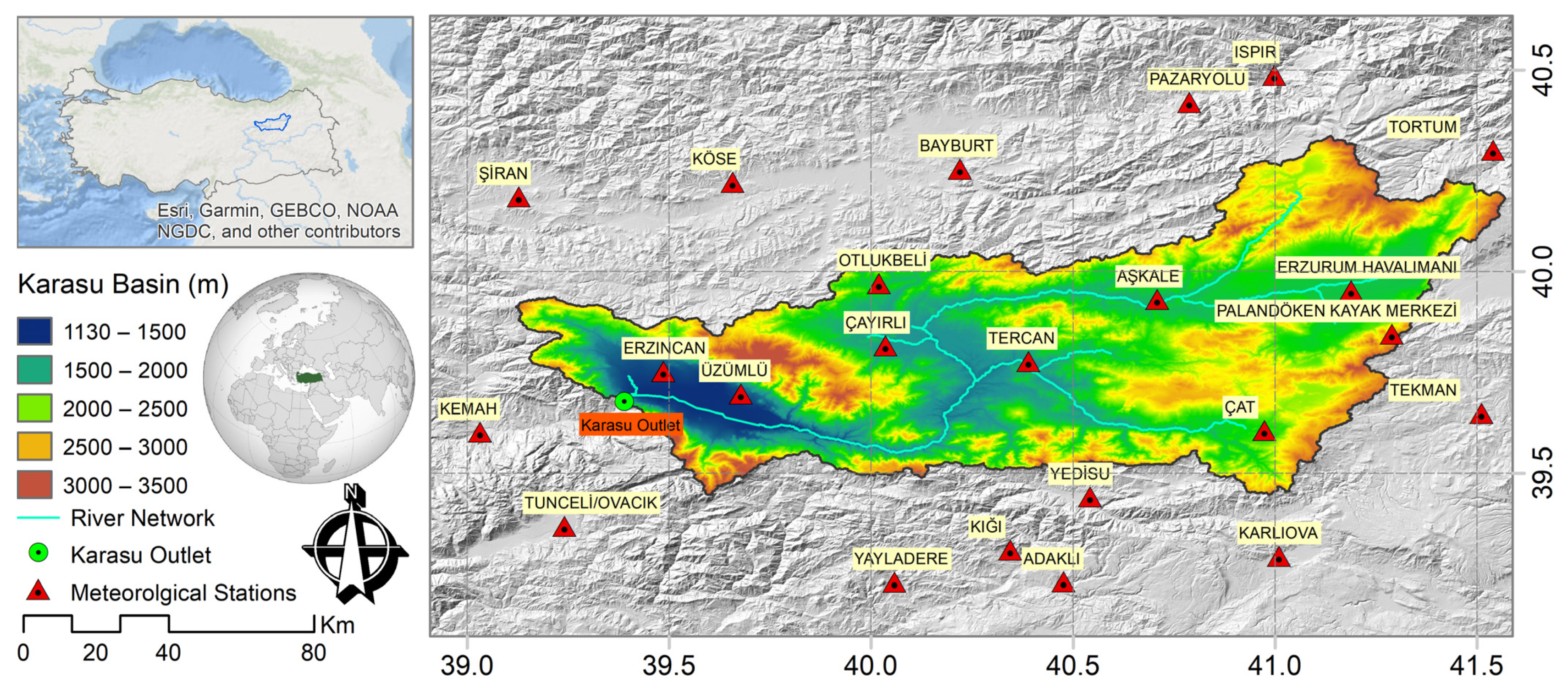
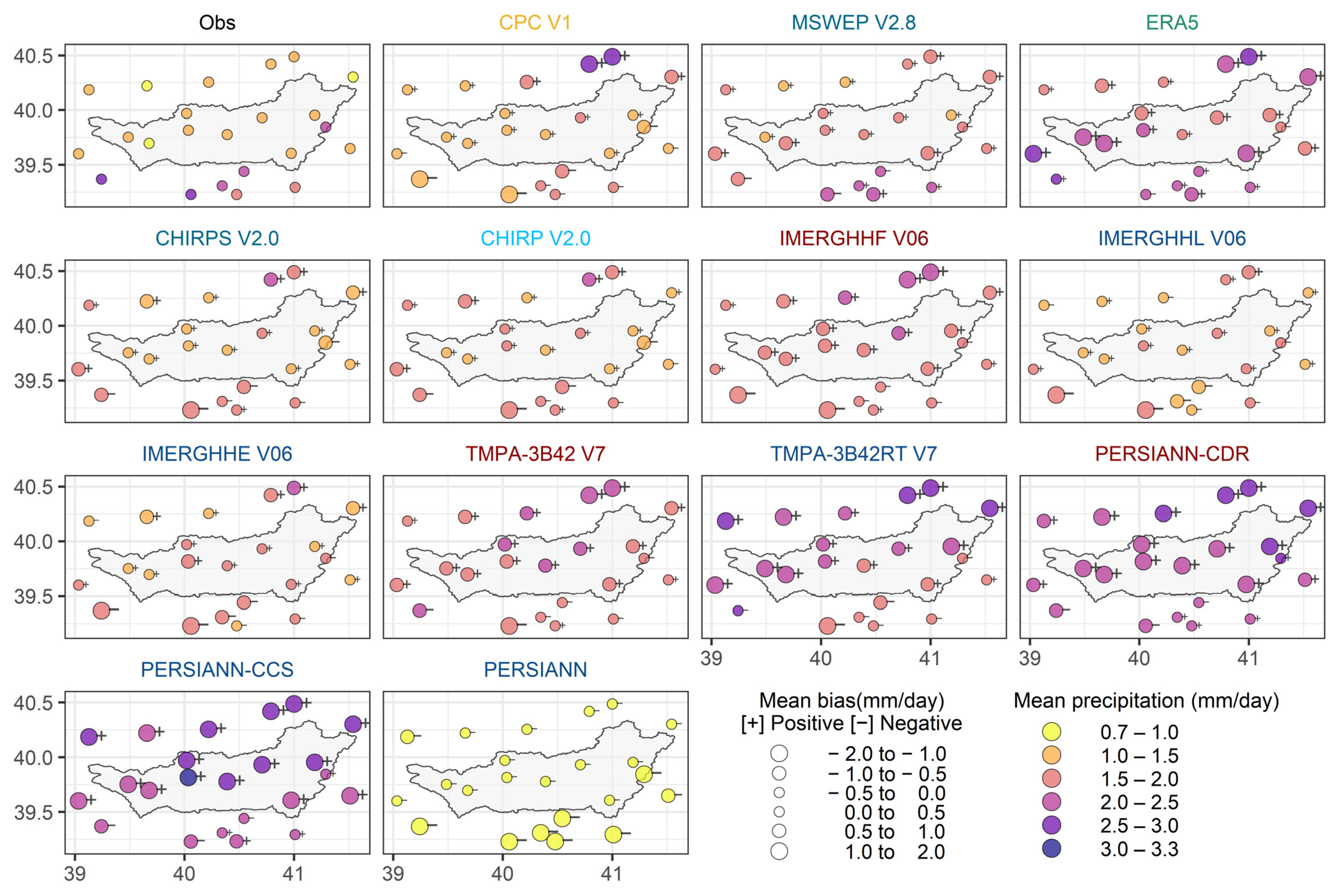
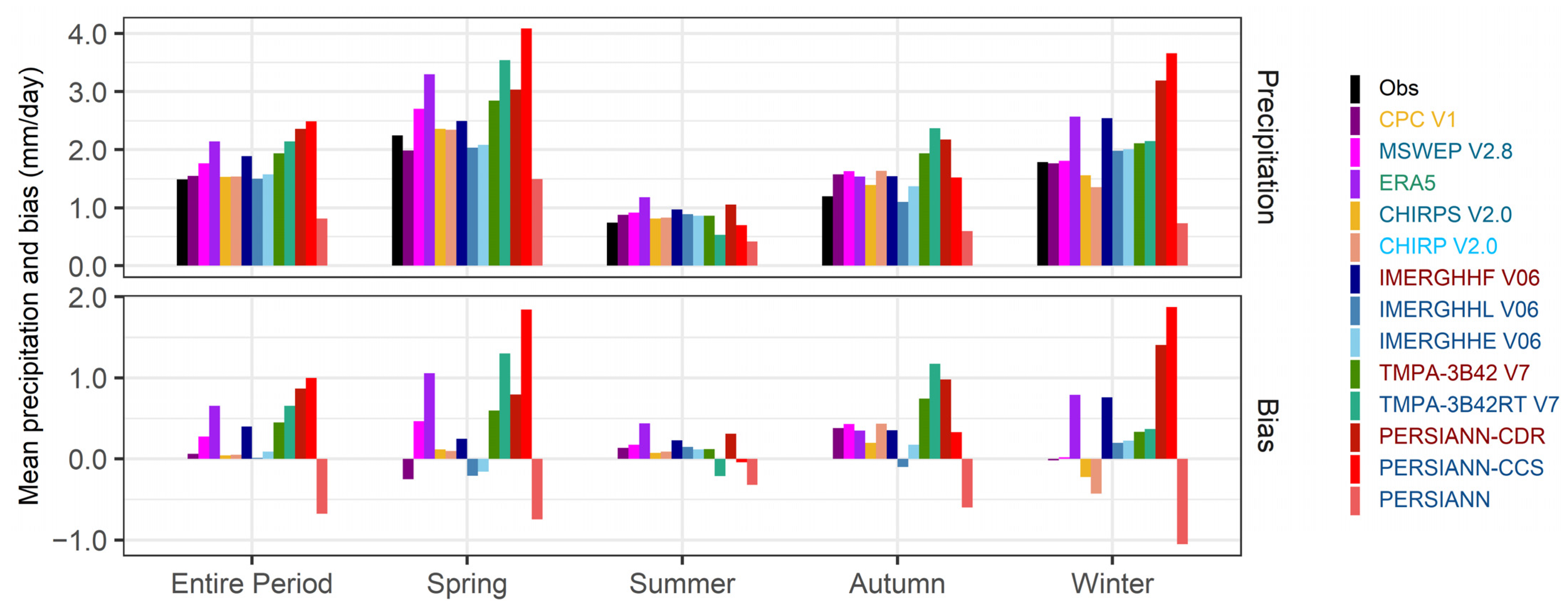







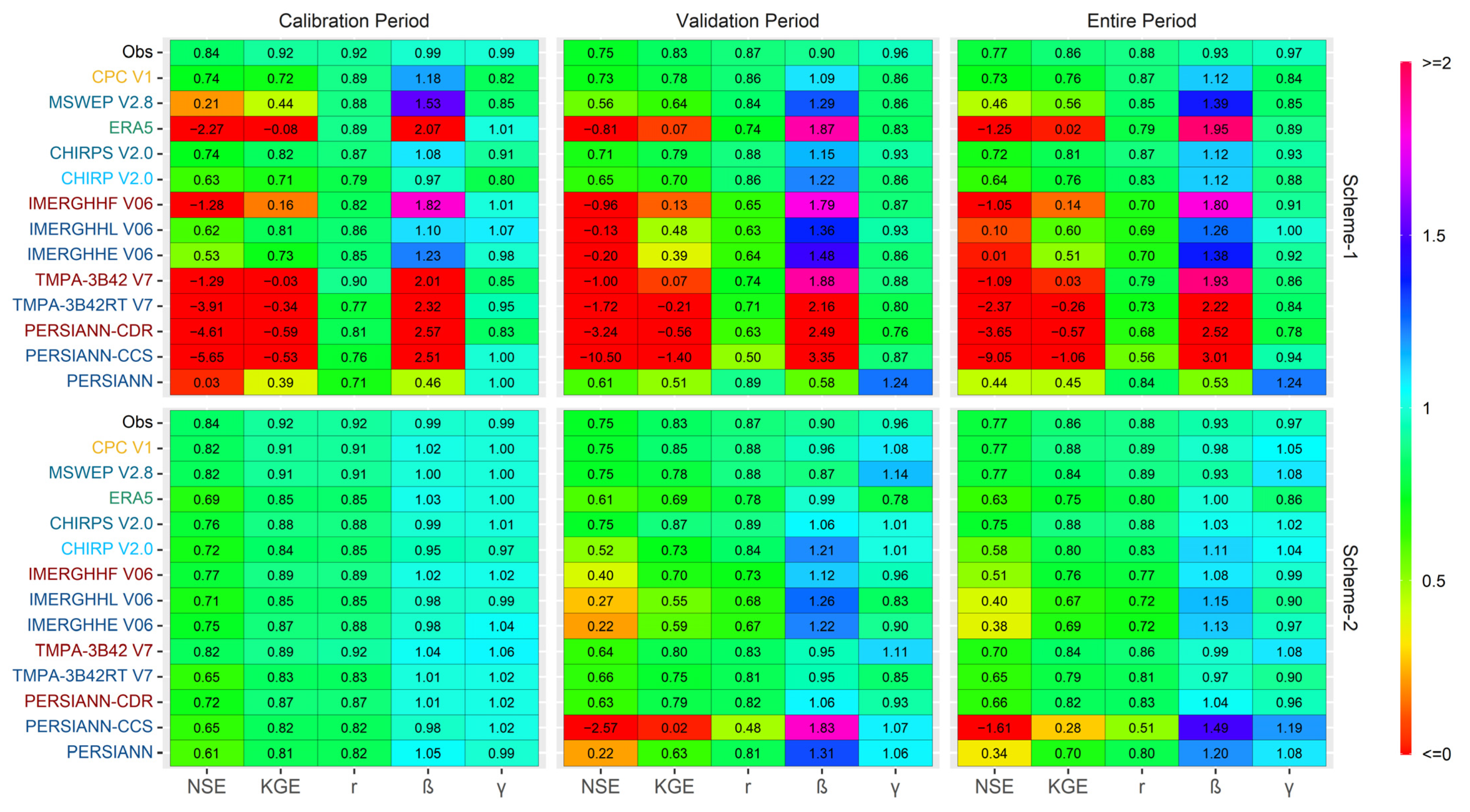
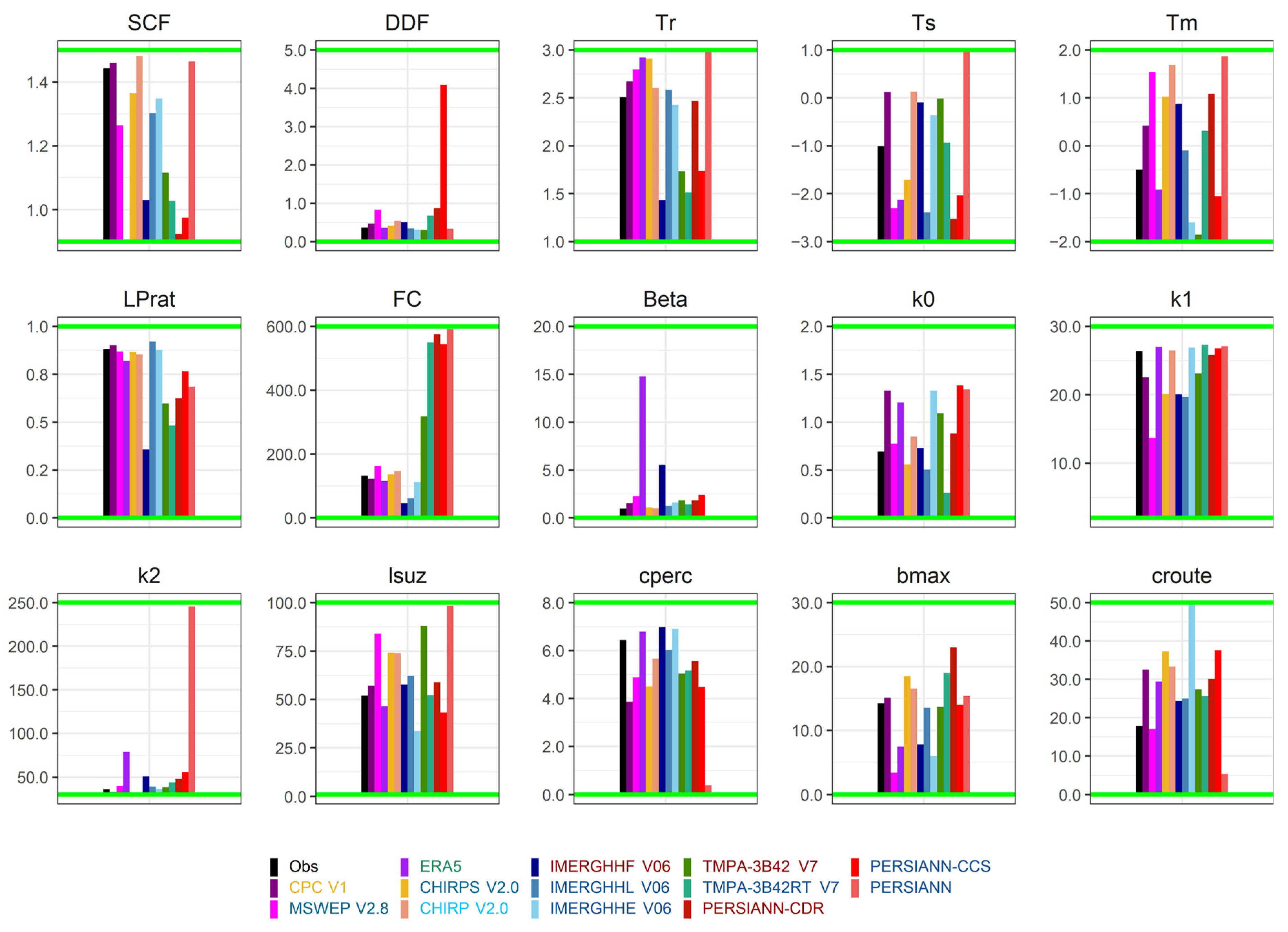
| Dataset Name | Data Source(s) | Spatial Resolution | Spatial Coverage | Temporal Resolution | Temporal Coverage | Latency | References |
|---|---|---|---|---|---|---|---|
| CPCv1 | G | 0.50° | Global | Daily | 1979–Present | 1 day | [40] |
| MSWEPv2.8 | G, S, R | 0.10° | Global | 3-hourly | 1979–NRT | Few months | [41,42] |
| ERA5 | R | 0.25° | 50° N/S | Hourly | 1979-Present | 3 months | [43] |
| CHIRPSv2.0 | G, S, R | 0.05° | L-50° N/S | Daily | 1981–NRT | 1 month | [44] |
| CHIRPv2.0 | S, R | 0.05° | L-50° N/S | Daily | 1981–NRT | 2 days | [44] |
| IMERGHHFv06 | G, S | 0.10° | 60° N/S | 30 min | 2014–NRT | ~3.5 months | [45] |
| IMERGHHEv06 | S | 0.10° | 60° N/S | 30 min | 2014–NRT | 4 h | [45] |
| IMERGHHLv06 | S | 0.10° | 60° N/S | 30 min | 2014–NRT | 14 h | [45] |
| TMPA-3B42v7 | G, S | 0.25° | 50° N/S | 3-hourly | 2000–Present | 3 months | [46] |
| TMPA-3B42RTv7 | S | 0.25° | 50° N/S | 3-hourly | 1998–NRT | 1 day | [46] |
| PERSIANN-CDR | G, S | 0.25° | 60° N/S | Daily | 1983–2016 | 3 months | [47] |
| PERSIANN-CCS | S | 0.04° | 60° N/S | Hourly | 2003–NRT | 1 h | [48] |
| PERSIANN | S | 0.25° | 60° N/S | Hourly | 2000–NRT | 2 days | [49] |
| Performance Indicator | Mathematical Statement | Explanation |
|---|---|---|
| Kling-Gupta Efficiency and its components | r (Pearson correlation coefficient), β (Bias) is the ratio of estimated and observed mean, γ (Variability Ratio) is the ratio of estimated and observed coefficients of variation, µ and δ are the distribution mean and standard deviation where s and o indicate estimated and observed. M (Miss); when the observed precipitation is not detected. F (False); when the precipitation is detected but not observed, H (Hit); when the observed precipitation is correctly detected, CN (Correct Negative); a no precipitation event is detected. n is the sample size of the observed or calculated streamflow. and present the observed and simulated streamflow, present the mean observed streamflow. | |
| Hanssen-Kuiper | ||
| Nash-Sutcliffe Efficiency |
| No | ID | Description | Units | Process | Range |
|---|---|---|---|---|---|
| 1 | SCF | Snow correction factor | - | Snow | 0.9–1.5 |
| 2 | DDF | Degree-day factor | mm/°C/day | Snow | 0.0–5.0 |
| 3 | Tr | Temperature threshold above which precip. is rain | °C | Snow | 1.0–3.0 |
| 4 | Ts | Temperature threshold below which precip. is snow | °C | Snow | −3.0–1.0 |
| 5 | Tm | Temperature threshold above which melt starts | °C | Snow | −2.0–2.0 |
| 6 | LPrat | Parameter related to the limit for potential evaporation | - | Soil Moisture | 0.0–1.0 |
| 7 | FC | Field capacity | mm | Soil Moisture | 0.0–600 |
| 8 | BETA | Non-linear parameter for runoff production | - | Soil Moisture | 0.0–20 |
| 9 | cperc | Constant percolation rate | mm/day | Runoff | 0.0–8.0 |
| 10 | k0 | Storage coefficient for very fast response | day | Runoff | 0.0–2.0 |
| 11 | k1 | Storage coefficient for fast response | day | Runoff | 2.0–30 |
| 12 | k2 | Storage coefficient for slow response | day | Runoff | 30–250 |
| 13 | lsuz | Threshold storage state | mm | Runoff | 1.0–100 |
| 14 | bmax | Maximum base at low flows | day | Runoff | 0.0–30 |
| 15 | croute | Free scaling parameter | day2/mm | Runoff | 0.0–50 |
Publisher’s Note: MDPI stays neutral with regard to jurisdictional claims in published maps and institutional affiliations. |
© 2022 by the authors. Licensee MDPI, Basel, Switzerland. This article is an open access article distributed under the terms and conditions of the Creative Commons Attribution (CC BY) license (https://creativecommons.org/licenses/by/4.0/).
Share and Cite
Hafizi, H.; Sorman, A.A. Assessment of 13 Gridded Precipitation Datasets for Hydrological Modeling in a Mountainous Basin. Atmosphere 2022, 13, 143. https://doi.org/10.3390/atmos13010143
Hafizi H, Sorman AA. Assessment of 13 Gridded Precipitation Datasets for Hydrological Modeling in a Mountainous Basin. Atmosphere. 2022; 13(1):143. https://doi.org/10.3390/atmos13010143
Chicago/Turabian StyleHafizi, Hamed, and Ali Arda Sorman. 2022. "Assessment of 13 Gridded Precipitation Datasets for Hydrological Modeling in a Mountainous Basin" Atmosphere 13, no. 1: 143. https://doi.org/10.3390/atmos13010143
APA StyleHafizi, H., & Sorman, A. A. (2022). Assessment of 13 Gridded Precipitation Datasets for Hydrological Modeling in a Mountainous Basin. Atmosphere, 13(1), 143. https://doi.org/10.3390/atmos13010143






